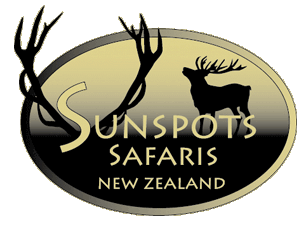| Axis |
Also known as chital or cheetal, the Axis deer is a native of Sri Lanka, Nepal, and India.
When introduced to New Zealand, the population reproduced so quickly that the government decided to exterminate them completely, and thus they are no
longer found in the country.
|
| Culling |
Culling is the process of selecting and killing animals on a relatively large scale. In New Zealand, culling was done to control the deer populations.
|
| Fair Chase |
Fair chase is the ethical, sportsmanlike, and lawful pursuit and taking of any free-ranging wild animal in a manner that does not give the hunter an improper advantage.
|
| Fallow |
Fallow deer originated in Turkey, spread to England around 150AD, then were released multiple times in New Zealand over about a 50-year period beginning in the late 1800's.
The bucks weight 130 to 200 lbs, and have antlers shaped a bit like a cross between a moose and a red deer, with a broad flat section
in addition to the pointed tines.
Today, they're found in many areas in the wild on both the North and South island.
|
| Fiordland |
An area in the south-western corner of the South Island of New Zealand, consisting of the steep Southern Alps, deep lakes, and large valleys to the west.
Fiordland's name comes from the Scandinavian "fjord", and the area does indeed have a number of fjords, the best known being Milford Sound.
|
| Free Range |
A large hunting area, where the game is not fenced in. Free range hunts can take place on both public and private lands.
|
| Game Estate |
A private piece of property established for the use of hunting, where the animals are farmed and hunting is controlled by the
owners of the property.
|
| Harem |
A herd of female deer dominated by a single male deer (stag) during the mating season.
|
| Hind |
A female deer.
|
| Rusa |
The Rusa deer are natives of Indonesia, and came to New Zealand via New Caledonia. Today, they live in a two small areas, one
near Galatea and another near the head of the Whakatane River.
|
| Rut |
The mating season, also known as the "roar". For red deer, the rut typically is from late March through late April.
|
| Sambar |
The Sambar is a large dark brown, maned Asian deer, typically 400-500lbs, but occasionally growing to as much as 1200lbs. Antlers can exceed 40 inches.
Sambar deer were brought to New Zealand by Europeans and today exist on the North Island.
|
| Sika |
Sika deer are also known as "Spotted Deer" or "Japanese Deer", originally found in the temperate and subtropical woodlands of Eastern Asia.
Sika were brought to New Zealand by Europeans and today exist on the North Island.
|
| Stag |
A male deer.
|
| Wapiti |
Introduced in the early 1900's by US President Teddy Roosevelt, Wapiti are a species of elk found in a 2000 square kilometer region of northern Fiordland.
Wapiti have interbred extensively with red deer, and today many hybrid animals can be found.
|
| White-tail |
White-tail deer came to New Zealand from New Hampshire, USA in 1905, liberated on Stewart Island. Today, a herd exists there, and another at Lake Wakatipu.
White-tails are a medium sized deer, with males weighing 130 to 300lbs.
|
